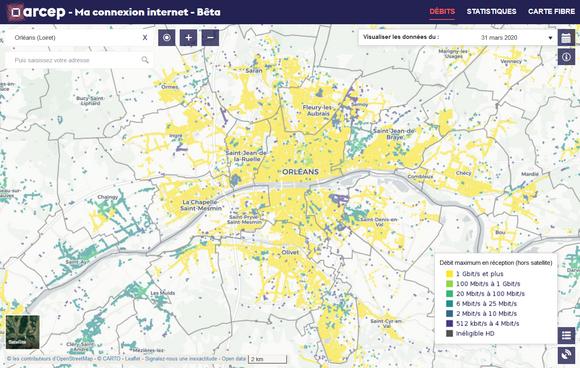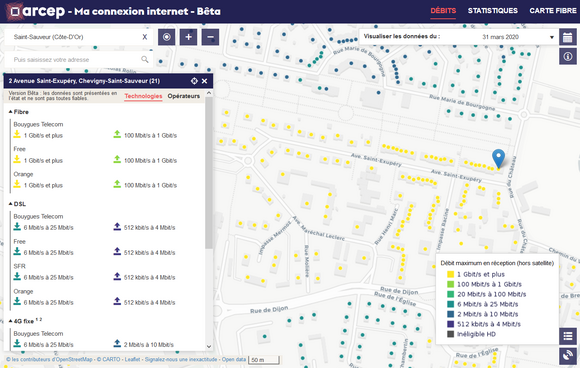Today, Arcep is publishing its scoreboard for the fixed broadband and superfast broadband market (rollouts and subscriptions) in France as of the end of September 2020. This quarter saw a record increase the rate of adoption for Fibre to the Home (FttH) access while deployments continued to advance at a very steady pace.
At the same time, Arcep has granted the status of “Fibre area” (zone fibrée) to two territories in the Aisne (51 municipalities) and the Loire (23 municipalities), where the departments are deploying optical fibre Public Initiative Networks (PIN), which is a sign of the tremendous progress that FttH is making in rural areas.
Lastly, Arcep is enhancing its “Ma connexion internet” map-based search engine devoted to fixed internet access, and is once again calling on the sector’s stakeholders to contribute to the work it is doing to increase the accuracy of the information provided by the site.
SUBSCRIPTIONS: exceptional progress in FttH subscriptions in Q3 2020
- Over the course of Q3 2020, the number of superfast broadband subscriptions (maximum download speed equal to or faster than 30 Mbit/s) increased yet again, this time by close to one million. The number of superfast subscriptions thus reached 13.6 million, or 45% of all internet access lines in France. Fifty percent of all subscribers in France now have a superfast access line, which is up three points YoY.
- All of this growth is due to an increase in the number of subscriptions to fibre to the home (FttH) plans, which have risen by close to 3 million year on year, bringing the total to 9.2 million as of 30 September 2020. This technology now represents more than two thirds of all superfast access subscriptions in France.
- The accelerated growth rate for superfast access adoption is going hand in hand with a more rapid decrease in the number of broadband connections: -2.2 million YoY versus -1.8 million one year earlier. Representing 16.7 million subscriptions, broadband access lines nevertheless still account for the majority.
- The total number of broadband and superfast broadband subscriptions stood at 30.3 million at the end of Q3 2020, which is 215,000 more than in the previous quarter and 685,000 more than the year before (+2.3% YoY).
ROLLOUTS: operators pick up the pace in the third quarter of 2020
Over the course of Q3 2020, more than 1.4 million additional premises were passed for FttH – which translates into a roughly 23% increase year on year, making it the second strongest quarterly increase ever. Close to 1.9 million lines have been deployed since the start of 2020, and this despite the Covid-19 crisis.
- As of 30 September 2020, 22.3 million premises were eligible to subscribe to an FttH access service, or 33% more than one year earlier.
- The majority of the growth continues to be in those parts of the country where the Government has issued a call for investment letters of intent (called "zones AMII" in French): close to 900,00 additional premises were rendered eligible during this past quarter, which reflects a tremendous push from operators.
- The accelerated pace observed nationwide is not, however, found in very high-density areas where the rate of progress has been insufficient for several quarters straight.
- The increased pace of FttH rollouts in areas covered by public-initiative rollouts produced the second strongest quarter ever, and the second highest increase of all time, with more than 450,00 additional premises passed in Q3 2020.
- In total, at the end of Q3 2020, 27.8 million households in France were able to subscribe to a superfast internet access service, all technologies combined, including 20.4 million households located outside of very high-density areas.
Monitoring operators’ compliance with their legally binding FttH rollout commitments
Arcep is responsible for monitoring operators Orange and SFR’s compliance with the obligations they have made in those parts of the country where the Government has issued a call for investment letters of intent (called "zones AMII" in French).
At the end of Q3 2020, around 72% of the premises in the municipalities where Orange made rollout commitments, and 82% of those where SFR has made commitments have been passed for fibre. The next scorecard, for Q4 2020, will provide an opportunity to obtain more accurate measure of the degree to which operators have met their targets.
Today, Arcep is expanding the publication of this monitoring process to include the other legally binding FttH rollout commitments that certain operators have made to local authorities, as part of calls for expressions of local interest (called "zones AMEL" in French).
What is being published today:
Missing elements that will be published in the coming weeks:
- Update of the cartefibre.arcep.fr site to include FttH rollout monitoring
- FttH network sharing figures
FIRST AWARDS OF “FIBRE AREA” STATUS
The status of “Fibre area,” (Zone fibrée in French) which is enshrined in law, serves to designate those territories with a fully deployed and operational superfast optical fibre network, and which have therefore fully laid the groundwork for the mass transition from copper to fibre. Areas that are granted this status are thus freed from previous obligations to install copper phone lines in Greenfield projects, whether individual homes, multi-unit dwellings or business premises.
On 1 December 2020, by virtue of Article L. 33-11 of the French Postal and Electronic Communications Code (CPCE), Arcep awarded the status of “Fibre area” to the first applications filed by:
- The company THD 42 Exploitation and the local authority, Intercommunal Energy Association of the Loire department (SIEL), in 23 municipalities in this department.
- The company Aisne THD and the local authority, Energy Sector Union of the Aisne department (USEDA), in 51 municipalities in this department.
These two awards testify to the strong rollout momentum observed in these two departments over the past several quarters and, more generally, to the growing pace of public-initiative network deployments.
What is being published today:
IMPROVEMENTS TO THE “MA CONNEXION INTERNET” SITE, TO PROVIDE MORE DETAILED INFORMATION ON CONNECTION SPEEDS AVAILABLE ACROSS THE COUNTRY
Released in beta in April, the “Ma connexion Internet” map-based search engine has benefitted greatly from the feedback provided by more than a hundred users: local authorities, prefectures, operators, businesses (help with moving, connectivity for teleworking) all contributed to the major improvements to the site initiated by the Authority. Arcep thanks them all most sincerely and, with this new version, is reiterating its call to the user community for additional feedback, with a view to launching a more complete and more reliable version of the site in spring 2021.
The ongoing work has made it possible to roll out a version of “Ma connexion internet” today that incorporates updated information (Q1 2020 data), the addition of a large number of local operators, enhanced map display features and more reliable data.


